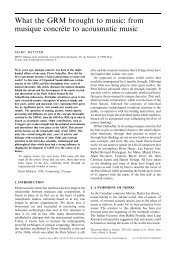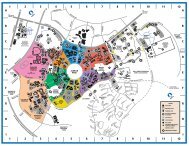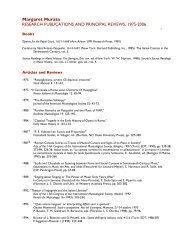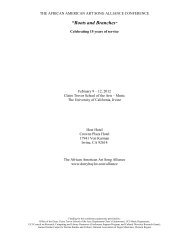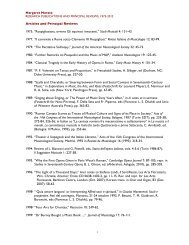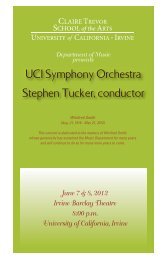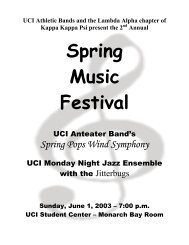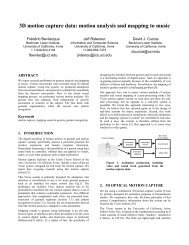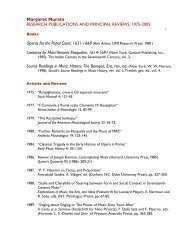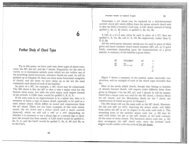Soundcraft Guide to Mixing - Music
Soundcraft Guide to Mixing - Music
Soundcraft Guide to Mixing - Music
- No tags were found...
You also want an ePaper? Increase the reach of your titles
YUMPU automatically turns print PDFs into web optimized ePapers that Google loves.
Bearing the above points in mind, the best approach is <strong>to</strong>use small amounts of boost, especially when working live.EQ cut, on the other hand, causes far fewer problems, andrather than boost a particular sound it is frequently morerewarding <strong>to</strong> apply cut in whichever part of the audiospectrum that appears <strong>to</strong> be overpowering. In this application,the sweep mid control is also very effective.Using a sweep-mid equaliserLike the high and low controls, the sweep mid can provideeither cut or boost, but its strength comes from the factthat it can be ‘tuned’ in<strong>to</strong> the specific part of the audiospectrum that needs treatment. Like the high and lowcontrols, it is more forgiving if used <strong>to</strong> cut rather than <strong>to</strong>boost. However, when first tuning in the mid control, ithelps <strong>to</strong> set it <strong>to</strong> full boost, so that when the frequencycontrol is adjusted, the effect is most apparent. This is trueeven if the final EQ setting requires cut rather than boost.ProcedureBelow is a simple way of eliminating unwanted sounds:Caution: when adjusting EQ, there is a danger offeedback which can cause damage <strong>to</strong> your speakers.You may need <strong>to</strong> reduce your levels <strong>to</strong> compensate.• Increase sweep-EQ gain.• Sweep the frequency pot until the aspect of the soundyou wish <strong>to</strong> modify becomes as pronounced as possible.This should only take a few seconds.• The cut/boost control is now changed from its full boostposition <strong>to</strong> cut. The exact amount of cut required can bedecided by listening <strong>to</strong> the sound while makingadjustments.• Even a small amount of cut at the right frequency willclean up the sound <strong>to</strong> a surprising degree.Other sounds may benefit from a little boost, one examplebeing the electric guitar which often needs a little extra bite<strong>to</strong> help it cut through the mix. Again, turn <strong>to</strong> full boostand use the frequency control <strong>to</strong> pick out the area wherethe sound needs help. Then it’s a simple matter of turningthe boost down <strong>to</strong> a more modest level and assessing theresults by ear.D. Using Effects UnitsThe Different TypesThe problem with mixing ‘dry’ (using no effects) within alive or recording environment is that the results can oftensound boring and lacking in colour. This is especially thecase as most of us are used <strong>to</strong> listening <strong>to</strong> highly polishedCDs at home. These productions are actually achieved byusing effects which electronically produce certainatmospheres. The different types of effects that can be usedare explained below;ReverbReverberation is the most commonly used studio effect,and also the most necessary. Western music is invariablyperformed indoors where a degree of room reverberation ispart of the sound. Conversely, most pop music is recordedin a relatively small, dry-sounding studio, so artificialreverberation has <strong>to</strong> be added <strong>to</strong> create a sense of space andreality. Reverberation is created naturally when a sound isreflected and re-reflected from the surfaces within a room,hall or other large structure. See fig. 10.FIG. 3.10REVERBDelayOften used <strong>to</strong> make a sound ‘thicker’ by taking the originalsound, delaying it, then mixing it back with the originalsound. This short delay added <strong>to</strong> the original sound has theeffect of doubling the signal.EchoA popular effect that was used extensively on guitars andvocals in the 60s and 70s. It is not used on vocals so muchnowadays, but quite effective on guitars and keyboards. Aneat trick is <strong>to</strong> set the echo delay time so that the repeatscoincide with the tempo of the song.Chorus & FlangingBoth chorus and flangers are based on a short delay,combined with pitch modulation <strong>to</strong> create the effect of twoor more instruments playing the same part. Flanging alsoemploys feedback and is a much stronger effect. Both theseSECTION 3: <strong>Mixing</strong> Techniques13



